
TWiV discusses an outbreak of influenza H5N1 that killed over half of the great cats at a Washington sanctuary, origin and cross-species transmission of bat coronaviruses in China, and the diverse and abundant phages that enter cells via receptors encoded on conjugative plasmids.
Hosts: Vincent Racaniello, Rich Condit, and Jolene Ramsey
Click arrow to play
Download TWiV 1181 (68 MB .mp3, 113 min)
Subscribe (free): Apple Podcasts, RSS, email
Become a patron of TWiV!
Links for this episode
- Support science education at MicrobeTV
- ASV 2025 4:37
- H5N1 virus kills great cats at Washington sanctuary (CNN) 8:10
- Macroevolution of bat coronaviruses in China (Nat Comm) 10:15
- EcoHealth Alliance funding suspended (Science) 32:00
- Conjugative plasmids support diverse and abundant phages (Nat Comm) 38:35
- Letters read on TWiV 1181 1:25:05
- Timestamps by Jolene. Thanks!
Weekly Picks 1:34:24
Rich – Pareidolia (wiki)
Jolene – Pathways to Science database
Vincent – Wendy Carlos and Switched-On Bach
Listener Picks
Arjan – Gutsick Gibbon’s YouTube channel
Alan – 2024 Nobel Prize Lectures in Chemistry
Intro music is by Ronald Jenkees
Send your virology questions and comments to [email protected]
Content in this podcast should not be construed as medical advice.
The post TWiV 1181: Seek and ye shall find, coronaviruses and phage first appeared on This Week in Virology.

Hello from Japan! I am taking “Virology” at Coursera and enjoying it very much! Well, I just heard you talking about microphones in Karaoke place… How contaminated they are. Actually, when you go in Karaoke place in Japan, you will find microphones with a plastic cover which says “disinfected”. (^_-)-☆
Hi Yukie, thanks for that bit of interesting information – do they change the plastic cover after each performer? That would make perfect sense. Glad to hear you are enjoying virology at Coursera!
Vertebrate-infecting plant virus??
Ummmm…I have argued previously, and I will again, that the Gibbs / Weiller paper does NOT state the most parsimonious case for the origin of circoviruses – or the purported acquisition of a “calicivirus” gene. Additionally, nanoviruses and circoviruses are both around now, meaning it would be hard to postulate that one evolved from the other. The presence of geminiviruses might also be seen to muddy the waters slightly, as possibly the biggest non-phage assemblage of ssDNA viruses.
Hang on, I thought geminiviruses evolved from a plasmid carried by bacteria that infect plants? (http://www.ncbi.nlm.nih.gov/pubmed/19460138).
On the other hand, it seems likely that rhabdoviruses that infect plants evolved from an animal-infecting virus, and not the other way around, since all the other Mononegavirales infect animals. I would guess the same goes for TSWV.
Hi from northern Italy. What a nice surprise is to have this blog as an added value to your Virology at coursera! I am not afraid to admit that I am enjoying both of them, even though as a PhD in molecular biology and Biotech (and having used both lenti and adenov for a while) I should know these topics pretty well. But as you know, there is no limit in learning and in keeping the pace with novel perspectives. Your podcast is a good companion on my motorbike-drive to/from work. Thanks
Dear Vincent,
Thanks for the link to Socrative. I have been looking for something just like that. This year I have been trying to do clicker questions using the university’s Moodle platform, but it’s a bit clunky, and less than a quarter of the students bring a laptop to the lecture.